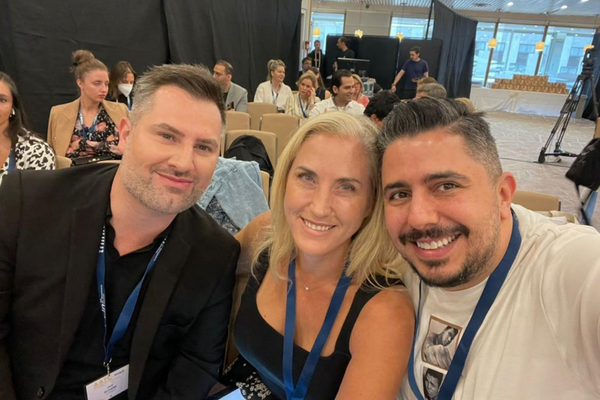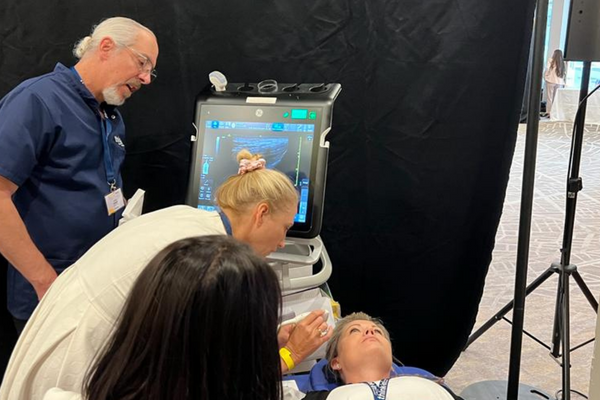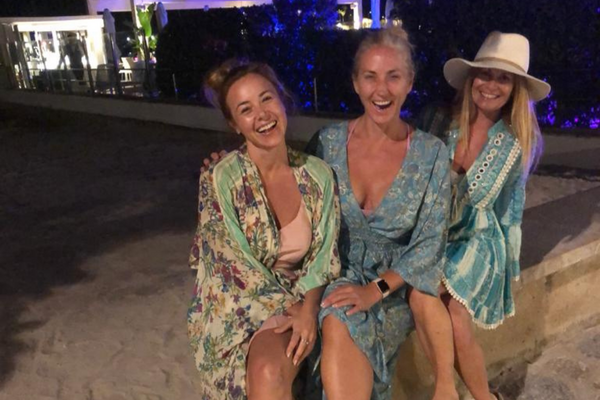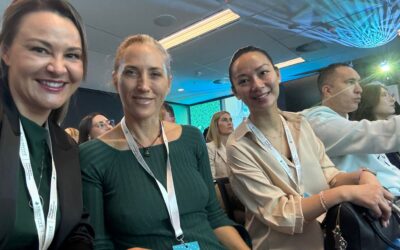Ah Paris! In my last update I had just arrived in Paris for my first international ‘in person’ conference in over two years. The Paris conference was huge this year, with nearly 15,000 attendees from 121 countries, the biggest attendance yet! It may have been pent-up demand post Covid, or the fact they moved it to Paris in the spring/summer rather than mid-winter 😹
For the five days of conference, I first attended the AATC pre-conference two-day course. The key driver for me attending this was training with some of the global experts who have been using ultrasound in cosmetic medicine. This modality is a new innovation in our industry worldwide, allowing trained practitioners to see on ultrasound a patient’s individual anatomy, before, during, and/or after injecting. It can be helpful to localise where the blood vessels are in high-risk areas so we can actively avoid them, help us understand where previous filler has been placed (along with what type of filler it’s likely to be), and for more accurate localisation of filler while using the dissolving enzyme hyaluronidase.
I am still weighing up the benefits of adopting ultrasound in our practice. While I can see it would be very helpful in a small number of cases, there is definitely a massive learning curve with training to become proficient in ultrasound, almost as much as with training in injecting. Two days of training is not enough – we would need to practice for weeks to months to become competent at it. The ultrasound machines are also expensive, and we would need to charge for the extra time required for each scan, plus to pay for the machine 🤷♀️ On the flip side, I see additional benefits with our training workshops – it could be useful in helping newer injectors to understand the layers of anatomy in the face and how variable each person’s individual anatomy is, as well as being able to assess which level they have put fillers into after they have injected in training.
I’d love your input – do you think it’s worth us getting an ultrasound machine? Would you pay extra to have your arteries mapped out before having filler so we can avoid the rare risk of blocking a blood vessel? Or to know what type of filler you have had previously or exactly where your filler is placed? Click here to have your say.
During the two-day pre-conference course, we also had a play with some new 3D-printed face simulators where you can inject the ‘face’ and then peel the layers back to check you have injected where you thought you were injecting. While this was fun and interesting, it didn’t really add much to my practice, other than to confirm that I’m injecting the layers accurately (thankfully, after 21 years of injecting!). Where it could be helpful is for beginner injectors who are just starting out.
It was awesome to share the AATC course with my dear friend and colleague Dr Jake Sloane, who started our ‘Hive’ of global trainers, and runs the Inside Aesthetics podcast; and Dr Rami Abadi, who is an international KOL (key opinion leader) for Allergan, and part of our Hive. I made them sit up the front with me so I could take great notes… I’m a nerdy swot like that! 😹
Then we went into the three days of IMCAS conference, where I had to pace myself to make sure I maintained my energy for the full five days. It was awesome to connect with existing and new friends from our global ‘Hive’, and a lot of the value of the face-to-face conferences is sharing ideas, experiences and research with colleagues of this calibre.
There are some new products on the horizon – some already in use in Europe, South Africa and South America, but sadly a few years away from hitting the Australasian/Pacific market. There are hundreds of different ‘me too’ fillers available in Europe as their regulations are a lot less stringent than in our market or the US. However there were a few standout innovations that will be worth the companies investing in the long and expensive process to bring them to our part of the world.
HarmonyCa is a hybrid filler with 70% hyaluronic acid (HA) and 30% calcium hydroxyapatite (CaHA) which is proving extremely popular in Europe right now. Used just under the skin through the cheekbones, jawline and the hollow bit of cheek in front of the ear, it has been producing impressive ‘lifting’ for early sagging, as well as an improvement in skin texture. It’s a different concept to the HA fillers as it has biostimulatory effects on the skin as well, and according to my UK and European colleagues who have been using it, has surpassed their expectations. At the moment, we are likely to have access to this product here in 2024-2025.
Hopefully before then we will have the Profhilo Body product available to treat skin laxity on the body – think jiggly arms, mushy belly, crinkly knees and wrinkly hands. The Profhilo body product is a different formulation to the one for face, neck and decolletage, with a higher concentration of HA and a 3ml syringe rather than a 2ml syringe. I actually think it’s quite good that we won’t get Profhilo Body straight away, as it means that they will have progressed in how to get the best results with the new formulation before it comes to us. In the meantime, we can still use the 2ml product in these areas, and I will be training the body areas in our upcoming Profhilo Workshop on the 18th July.
There was a lot of discussion about new forms of BotoxⓇ coming out over the next 5+years. The first ‘liquid Botox’ formulation was launched at IMCAS – until now, all of the neuromodulators have come as a freeze-dried powder that we make up with saline to get it out of the vial and into the patient. The pre-made liquid will take this reconstitution step away to save time for the injector. It remains to be seen whether this product will take off in the market, as most injectors have different amounts of saline that they prefer to use when they reconstitute the vials. Some will use a 1ml dilution while others prefer a 10ml dilution. At TFP we use the standard 2.5ml dilution which has been the most studied, but will sometimes ‘double dilute’ to 5ml if we want the product to spread more, or for an excessive sweating treatment. Some injectors will use different dilutions for different areas of the face. So the one fixed dilution with the premade liquid BotoxⓇ might actually be a drawback for some. I’m going to be watching this space though!

Behind the scenes with my international industry colleagues.
Other new botulinums in the pipeline include ‘longer lasting’ formulations (although looking at the research they are just using really high doses and freezing or completely immobilising the muscles), and a shorter acting one that works within a day or so and is gone within a few weeks – which could be good if someone wants it just for a special occasion, or is nervous and just wants to try it out. These are both a few years away from coming to us.
I also went to some of the lectures on stem cells and regenerative medicine, and threads, just to see if there was any new information or innovations that might change my mind in them. I continue to monitor these modalities but didn’t see anything this time that made me want to offer them in clinic.
The overall take home message from IMCAS was that at TFP we are totally up with the play with the latest recommendations from the world stage on techniques and preventing/managing complications, which was reassuring!
I’ll be passing on some of what I learned in our upcoming training workshops where I’ll be teaching doctors and nurses from the industry, alongside some members of our team, at our Profhilo Workshop, Vampire Academy and Hyalase Workshop. Our first Profhilo Workshop on 18 July sold out quickly, and we have an almost full waitlist for a second workshop, so if you are in the industry and interested you can book or register your interest here.
You may notice we’ve had some changes in our team over the last 6-12 months, and I’m thrilled and excited at the calibre of people we are bringing to the team. We had a massive shock last month when our GM of almost 11 years, Dee, was offered an incredible role in the crypto industry – an area she has grown passionate about in the last few years – with Easy Crypto as their Chief of Staff. Dee has been my right hand and also took over my CEO role the last 7-8 months while I have been on health leave, so had the potential to leave a huge hole. Instead, she found someone incredible to replace her, who had all her skills plus existing experience in this industry, and I’m delighted that Nicci Coleman has stepped into the GM role and is already flying and filling me with confidence after only a couple of weeks. It’s a wonderful reminder that often changes brings new growth and new ideas, and I’m excited for what Nicci brings to the table.
Unfortunately at the moment, we have been hit with a lot of illness in our team – like almost everybody else – and so we ask for your patience if we need to change or reschedule your appointments. We are currently fully booked several weeks in advance, so if you are wanting an appointment, get in quickly, or leave your name on our waitlist – with so much sickness happening for everyone, we often have last-minute appointments that become available!
I finally got Covid – most likely while at IMCAS Paris, as I developed mild symptoms almost as soon as I arrived in Mallorca the night the conference finished. There had been a lot of people smoking in Paris (they still smoke in restaurants there – gross!), and I had purposely paced myself due to the long-standing effects of Tamoxifen on my energy, so I thought that was why I felt exhausted and had a sore throat and mild cough. It was a big surprise when I did my pre-travel Covid test to fly home and tested positive! I was very fortunate that I had mild symptoms at the time, and grateful that it gave me another week in the Mallorca sunshine to recover, rather than being stuck in isolation at home. There were no isolation rules in Mallorca for mild Covid, so my friends and I were able to go to the beach and on hikes to watch the sunset, despite testing positive (fortunately – it was super hot at 33-34C!). Once my symptoms had completely gone, my friend Rani and I went to Rafael Nadal’s family restaurant and had lunch there, which was super cool! The extra week definitely helped refill my cup with sun and laughter.
Unfortunately, the exhaustion hit me when I got home to NZ instead! For the first 10 days I was sleeping 10-16 hours a day, probably a combo of jet lag, Covid recovery and residual Tamoxifen effect. I also still have that annoying post-viral cough that seems to stick around!
Having Covid has also delayed my next planned breast surgery, which was meant to happen on 23 June, as my surgeon won’t do elective surgery under a general anaesthetic for at least eight weeks after someone has had Covid. This time around I was meant to have some cosmetic tidying of the breast and tummy, with fat grafting to improve the shape of the breast and a scar revision. I’ve now delayed this until next year, as I had planned the rest of this year around having surgery on 23 June!
My energy was starting to get a lot better before I went to Europe, and Paris was always intended to be a test of how my brain and body managed the workload. Unfortunately, with getting Covid, my energy has slipped back again, and I’m still limited to 10 hours a week of work, so my focus for the next few months will be on training and further upskilling our team, and getting our fabulous new GM completely across all parts of the business. I’m hoping to start doing some reduced injecting hours in the pre-Xmas period to help out the team in our busiest time of year, but also know that I am here supporting and mentoring our team in the background.
With another wave of Covid and flu predicted to hit NZ over the next few weeks, I hope you manage to stay well. Thank you for your patience as we navigate staff shortages due to the onslaught of illness. Stay well and happy!
Love, Dr Cat 😻











